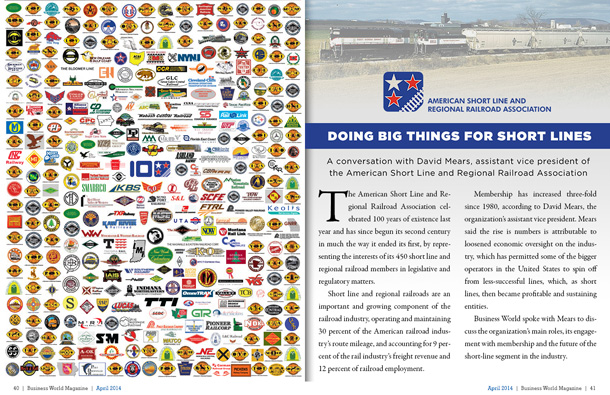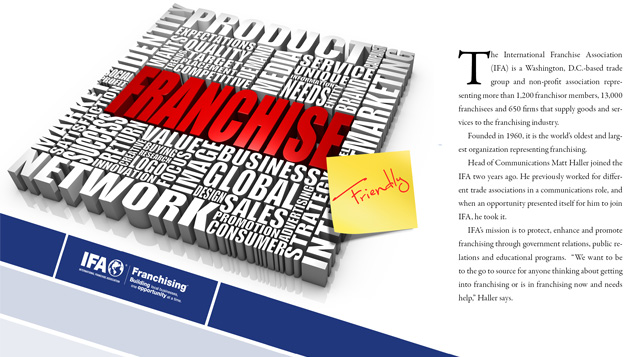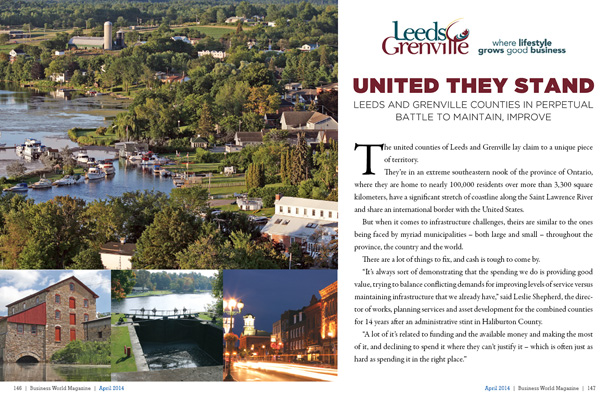
Doing Big Things for Short Lines
A conversation with David Mears, assistant vice president of the American Short Line and Regional Railroad Association

The American Short Line and Regional Railroad Association celebrated 100 years of existence last year and has since begun its second century in much the way it ended its first, by representing the interests of its 450 short line and regional railroad members in legislative and regulatory matters.
Short line and regional railroads are an important and growing component of the railroad industry, operating and maintaining 30 percent of the American railroad industry’s route mileage, and accounting for 9 percent of the rail industry’s freight revenue and 12 percent of railroad employment.
Membership has increased three-fold since 1980, according to David Mears, the organization’s assistant vice president. Mears said the rise is numbers is attributable to loosened economic oversight on the industry, which has permitted some of the bigger operators in the United States to spin off from less-successful lines, which, as short lines, then became profitable and sustaining entities.
Business World spoke with Mears to discuss the organization’s main roles, its engagement with membership and the future of the short-line segment in the industry.
BUSINESS WORLD: Some specific short-line operators have been able to capitalize when larger railroads no longer had interest in certain lines, by going in and cultivating business. Is that a fairly pretty common theme among short lines?
DAVID MEARS: It is. Because of the fact that short lines are local, often have greater flexibility than the larger railroads in terms of responsiveness to customer needs and also because they have lesser overhead, they can be quite competitive in providing rail service, whereas a larger railroad may not have been quite so capable.
BW: Is the industry sustaining itself for reasons of customer satisfaction, too?
MEARS: That is correct. That’s exactly right. It’s there as a viable business entity, a viable business model. Short lines are providing a vital need in terms of getting goods to and from market.
BW: Is there a great deal of variance in short lines between large and small, or are they fairly uniform in size?
MEARS: Some of the largest are several hundred miles in length, and the smallest may be one or two miles in length.
BW: As far as the membership goes, are you mainly some of the bigger ones? Or are you a little bit of all?
MEARS: We’re a good mix. We have a lot of the regional, or medium-sized railroads, as members – most of them, or nearly all of them as far as I know, and the short lines, or small railroads, whatever you want to call them, as well as a good mix. Now one thing of interest about, I believe, a quarter of the railroads are owned by what we call holding companies and that’s basically a conglomerate that owns more than one. There’s one very large conglomerate called Genesee and Wyoming that owns over 100 short lines and there are some lesser ones. I think Watco operates somewhere between 20 and 30. And so that represents, I would say, a quarter to one-third of the short lines that are run by these holding companies. The remaining two-thirds are pretty much independent.
BW: Would Genesee and Wyoming then be a member of your organization or would the individual railroads be?
MEARS: The individual railroads would be. Of course, we’re closely in touch with Genesee and Wyoming, because they’re of considerable importance.
BW: When a short line is considering membership, what are they typically looking for from you?
MEARS: What we do is provide representation for them in addressing national issues. We look out for their interests at the federal level. We additionally help them with meeting federal requirements related to regulation, related to providing information. We do a lot of information relaying and communications, so that they can keep on top of matters, and of course, we’re also here to answer any questions that they may have concerning the particulars of running a railroad.
BW: How many people do you have working for you?
MEARS: We have 12 people and I always pride myself on that. If you look at it in terms of total mileage, the short lines, the regional railroads, the small and medium-size railroads of the United States, make up a third of the national rail network. The other two-thirds is the seven big companies. But I think it’s interesting, and I’m not trying in any way to be self-congratulating, but here we have 12 people that look out for the interests of about 450, 500 railroads, another 450, about 500 companies that supply and serve railroads and there’s just 12 of us here in the office. So, as I like to say, there’s 12 of us here sustaining a third of the industry.
BW: Associations will generally they’ll have one flag that they plant in the ground and say we are this to our members, and that’s what they value in us. What do you consider your primary strength?
MEARS: We look out for their legislative needs, for their regulatory requirements, and for the networking possibility, we have a number of events that we stage throughout the year that allow them to get together and talk. We have a number of committees in which we advance certain issues, such as technology, legislative policy, mechanical, passenger – we have a committee that looks at that actually, because 40 or 50 short lines cross inter-city passenger traffic or commuter traffic. So that’s the flag we plant in the ground – is to try and be multi-faceted.
BW: Talk about your convention later this month.
MEARS: We call it the premier event of the railroad industry – it’s not just for little guys, it’s for everybody. That event has been growing in popularity and we now have, last year we had nearly 2,000 people attend, and we also have a reputation for putting on excellent and informative programs, as well as having the opportunity for these hard-working people to have a little bit of fun while they’re there, and, I mean in a totally respectable way.
BW: If I’m a short line railroad and I’m a member of the organization, what issues are on the top of my agenda right now? What am I most concerned about? What is the membership most often coming to you about with issues?
MEARS: I think the ones they’re coming to us the most about are how to address the various regulatory requirements that are ongoing. The No. 1 legislative issue is that we have a short line tax credit that the particulars of are basically that you can get up to a $3,500 credit for any infrastructure work that you do. That is a very important one, because many of these railroads were cast off from the bigger railroads, not having a lot of maintenance the last couple of years of their operation, because they were knowing that they were probably going to get rid of them. So that has been the No. 1 effort. We’ve had a tax credit since, I believe 2004, that’s just done a world of good in helping these railroads to improve their infrastructure and rehabilitate it such that they can serve more customers and serve them better. The tax credit expired at the end of 2013, but we are working diligently to see that we can get the tax credit extended and enhanced.
Beyond that, there was an act passed in 2008, the Rail Safety Improvement Act, that regulations were going to be put forth for this, that and the other thing. So we’ve been working to address those issues as those translate into actual regulations with specifics. I would say those are probably the two biggest things we’ve got going right now – the effort to renew and enhance the short line tax credit, which was renewed in 2004, and also to mitigate or make work the various regulations that come down the pike from the Federal Railroad Administration and other regulating bodies.
BW: What are the prospects for renewal of the tax credit? Does it look good?
MEARS: We’re cautiously optimistic. We relate it to the past when the credit has been extended at the last minute with other deserving tax credits, as part of a omnibus bill that bundles them all together in what’s called a tax expendage package. So we’re cautiously optimistic and working hard to see that it, as it has in the past, gets renewed.
BW: Has that been a fairly bipartisan type of thing?
MEARS: Yes, it has. The Senate had 49 supporters and we’re confident that we can get a majority of the Senate to support it. The House bill, which is pretty much identical in content, has 229 co-sponsors and that number is changing daily as our members go out and talk to their congressmen and congresswomen about the importance of this tax credit. So we have majority support in the House and we expect that we can convince people to get majority support in the Senate.
They say that the tax credit is amongst the most widely supported of all of the tax credit legislations that are out there.
BW: If we were to revisit this conversation five years down the road, do you have specific goals for the organization? Do you have a membership number? Are there any other things in terms of the association that you want to see happen in that intervening time?
MEARS: I think that we just want to continue going onward and upward, try to make it possible for all railroads to become members, make sure we serve them with a great variety of tools and helpfulness for their needs, and I think as well, see to it that the interests we have on the national level are reflected in good policy and that we continue to do everything that we can to help railroads provide the basis for continuing to help prosper the American economy.
BW: Is there anything about the industry that you see changing? Will it just be what it is now five years down the road, or are there drastic game-changers on the way?
MEARS: Now, that’s a good question. The bigger railroads are dealing with positive train control, or when the trains would be automatically stopped or started. That is a bigger issue for the bigger railroads than it is for us. That’s a $20 billion unfunded mandate that they’re all having to go through to meet a requirement, even to the point of having to develop new technologies. That has probably been the biggest challenge for the big railroads. In terms of going five years down the road from now, we’ll probably continue to see the movement of these holding companies to acquire more railroads, because the short lines and regionals are turning out to be a good investment for them. But I see a continued strength and I think we’ll be in good stead having this conversation.
I think we’ll also see continued results from the renewal of that short line tax credit, which means better infrastructure, more repairs and just everybody healthier.








